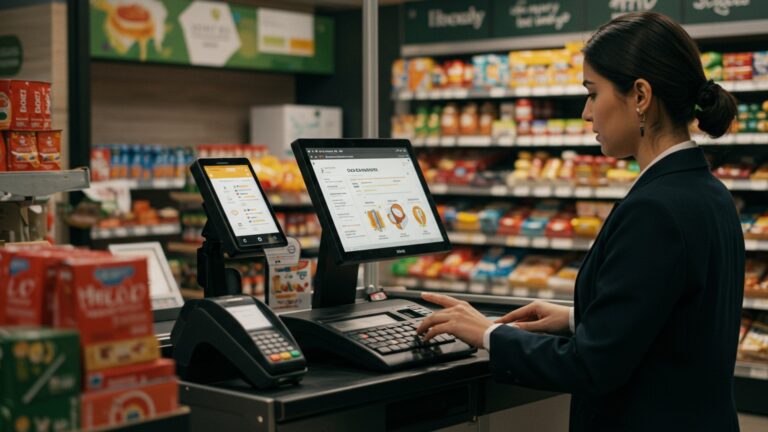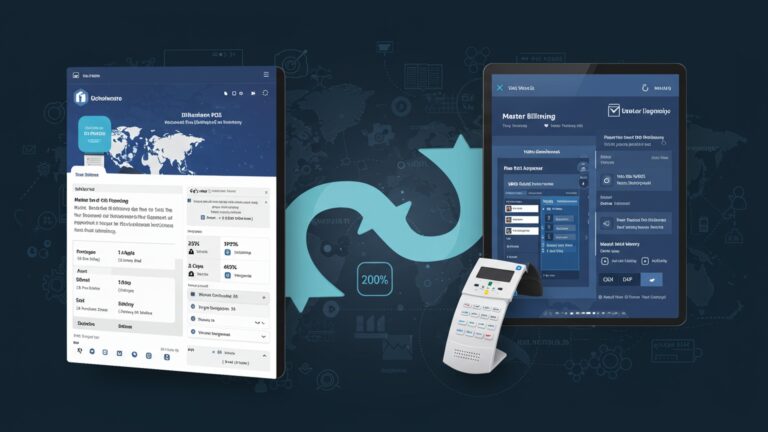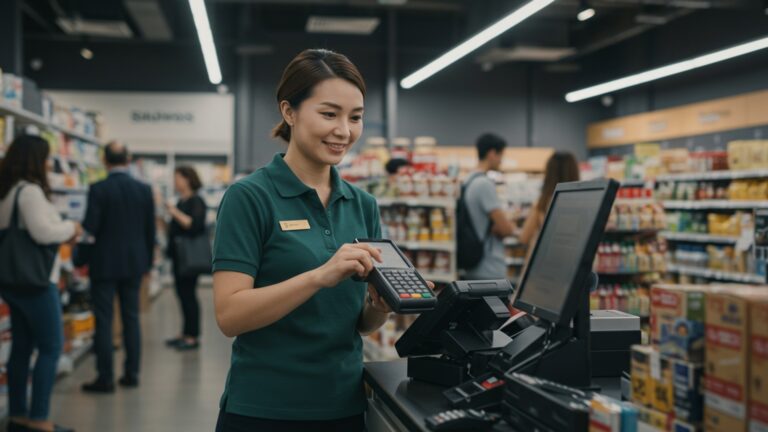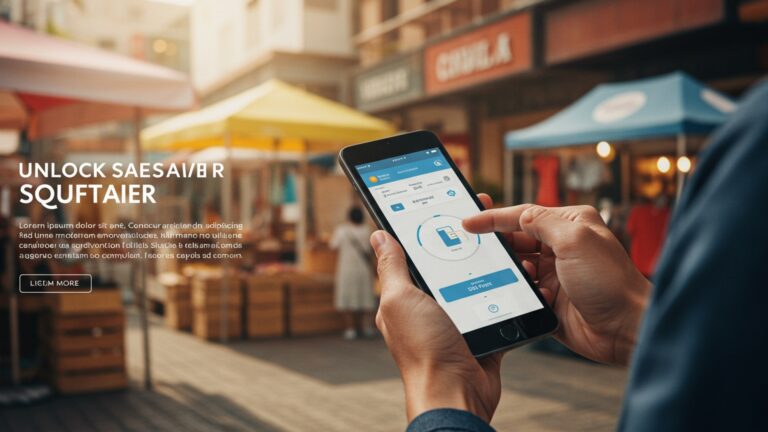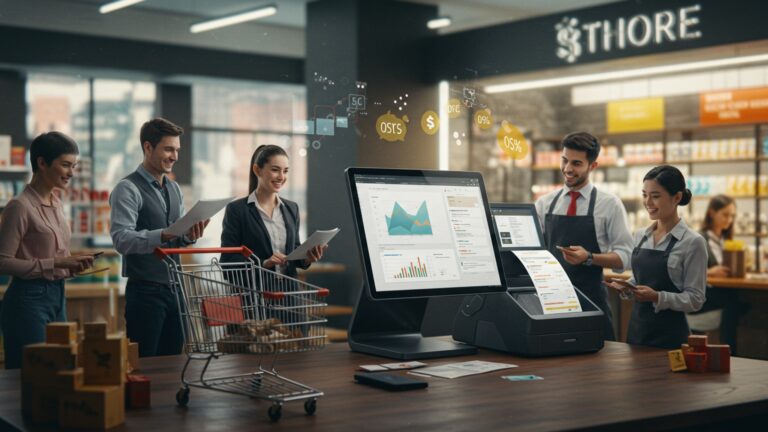How to Master Grocery Store Operations with Efficient POS Software
The contemporary grocery market demands unparalleled operational agility, navigating everything from fluctuating supply chain dynamics to heightened customer expectations for seamless, personalized shopping experiences. Mastering these complexities requires more than just traditional cash registers; it necessitates a sophisticated pos software for grocery store environments that transforms challenges into opportunities. Modern systems extend far beyond transaction processing, integrating real-time inventory tracking to minimize spoilage, accelerating checkouts with advanced scanning and contactless payment options like tap-to-pay. empowering data-driven decisions for pricing and promotions. This shift allows grocers to enhance customer loyalty through personalized offers, streamline staff workflows. gain comprehensive insights into sales trends, effectively future-proofing their business against an increasingly competitive landscape.

Understanding the Core: What is POS Software for Grocery Stores?
In the fast-paced world of retail, particularly within grocery operations, the Point of Sale (POS) system is far more than just a cash register. At its heart, POS software for grocery store environments is a comprehensive digital ecosystem that manages transactions, tracks inventory, handles customer data. provides invaluable insights into business performance. Think of it as the central nervous system of your grocery store, connecting various operational aspects to create a seamless experience for both customers and staff.
Historically, grocery stores relied on manual price look-ups, handwritten inventory logs. standalone cash registers. Today, modern POS software has revolutionized this by integrating these functions into a single, cohesive platform. When a customer checks out, the POS system doesn’t just calculate the total; it simultaneously updates inventory levels, records the sale, applies discounts. even collects data on purchasing habits. This level of integration is what transforms a simple transaction into a rich data point, driving efficiency and informed decision-making.
Key Features: The Pillars of Efficient Grocery Operations
To truly master grocery store operations, the right pos software for grocery store needs a robust set of features tailored to the unique demands of fresh produce, varied product lines. high transaction volumes. Here are the indispensable components:
- Rapid Checkout Processing
- Advanced Inventory Management
- Customer Relationship Management (CRM) Integration
- Employee Management
- Reporting and Analytics
- Scalability and Integration Capabilities
- Security Features
Speed is paramount in grocery. The software must facilitate quick item scanning (barcode, QR code), weight-based pricing for produce. efficient tender processing (cash, credit/debit, mobile payments, EBT). Features like ‘quick keys’ for frequently sold items or items without barcodes are also crucial.
This is arguably the most critical feature. It goes beyond mere stock counting, offering real-time tracking of inventory levels, automated reorder points, vendor management, product categorization (e. g. , dairy, produce, frozen). support for expiry dates. Effective inventory management minimizes waste, prevents stockouts. optimizes shelf space.
Modern grocery stores thrive on customer loyalty. POS software can track purchase history, manage loyalty programs (points, discounts). facilitate targeted promotions. This data allows for personalized marketing efforts, enhancing the customer experience and fostering repeat business.
Efficient POS systems help manage staff by tracking clock-ins/outs, sales performance. access permissions. This ensures accountability and helps identify top performers or areas needing training.
A powerful POS system provides detailed reports on sales trends, peak hours, popular products, profit margins. inventory turnover. These insights are vital for strategic planning, merchandising decisions. identifying operational bottlenecks.
As a grocery business grows, its POS system must grow with it. Look for solutions that can easily add new terminals, integrate with accounting software (e. g. , QuickBooks), e-commerce platforms, or enterprise resource planning (ERP) systems for a holistic business view.
Protecting sensitive customer data and preventing internal theft are critical. Robust POS systems include user access controls, data encryption. audit trails for all transactions.
Real-World Impact: How POS Elevates Grocery Operations
Let’s look at how a sophisticated pos software for grocery store transforms daily operations and strategic planning. Consider a local, independent grocery store, “Fresh Picks Market,” which recently upgraded its legacy cash registers to a modern cloud-based POS system.
Case Study: Fresh Picks Market
Before the upgrade, Fresh Picks struggled with:
- Long checkout lines during peak hours due to slow manual entry and price look-ups for produce.
- Frequent stockouts of popular items and overstocking of slow-moving goods, leading to lost sales and increased waste.
- Inability to track customer preferences, making loyalty programs ineffective.
- Time-consuming manual inventory counts and ordering processes.
With their new POS system, Fresh Picks experienced significant improvements:
- Faster Transactions
- Optimized Inventory
- Enhanced Customer Engagement
- Streamlined Management
Barcode scanners and integrated scales reduced checkout times by 30%, significantly shortening queues and improving customer satisfaction.
The POS automatically tracks sales and suggests reorder quantities based on historical data and projected demand. This led to a 15% reduction in inventory waste and a 10% increase in product availability, directly impacting profitability. For example, the system flagged an impending shortage of organic milk before it happened, allowing them to place a timely order.
Through the integrated CRM, Fresh Picks launched a successful loyalty program. Customers earned points that could be redeemed for discounts. the store could send targeted promotions (e. g. , a discount on gluten-free products to customers who frequently bought them). This resulted in a 20% increase in repeat customer visits.
Daily sales reports, accessible from anywhere via the cloud, allowed the owner to monitor performance and make data-driven decisions on staffing, promotions. purchasing. Time spent on manual inventory checks was repurposed for merchandising and customer service.
This anecdote illustrates how the right POS system isn’t just a tool; it’s a strategic asset that drives efficiency, customer loyalty. ultimately, business growth.
Comparing POS Solutions: Cloud-Based vs. On-Premise
When selecting pos software for grocery store, a fundamental decision involves choosing between cloud-based and on-premise systems. Each has distinct advantages and disadvantages:
| Feature | Cloud-Based POS | On-Premise POS |
|---|---|---|
| Data Storage | Data stored on remote servers, accessible via internet. | Data stored locally on your store’s servers/computers. |
| Accessibility | Access data and manage operations from anywhere with an internet connection (e. g. , a tablet, smartphone, laptop). | Access typically limited to the store’s physical location or via complex remote access setups. |
| Cost Structure | Subscription-based (SaaS model), lower upfront costs, predictable monthly fees. | High upfront costs for hardware and software licenses, ongoing maintenance costs. |
| Maintenance & Updates | Provider handles all software updates, security patches. server maintenance. | Requires in-house IT staff or external contractors for maintenance and updates. |
| Scalability | Easily scalable; add or remove terminals/features as needed without significant hardware changes. | Scaling often requires significant hardware upgrades and additional software licenses. |
| Security | Managed by professional data centers with robust security protocols and regular backups. | Security is your responsibility; dependent on your internal IT expertise and infrastructure. |
| Internet Dependency | Requires a stable internet connection for full functionality (though some offer offline modes). | Can operate without constant internet. may need it for external integrations or payment processing. |
| Ideal For | Small to medium-sized grocery stores, multi-location businesses, those seeking flexibility and lower IT overhead. | Large grocery chains with dedicated IT departments, those preferring full control over data and infrastructure. |
For most modern grocery stores, especially those looking for flexibility, lower initial investment. ease of management, cloud-based pos software for grocery store solutions are increasingly becoming the preferred choice. They allow owners to focus on selling groceries, not managing IT infrastructure.
Actionable Takeaways: Choosing and Implementing Your POS
Selecting and integrating the right pos software for grocery store is a significant investment. Here are actionable steps to ensure a successful transition:
- Assess Your Needs
- Research Thoroughly
- Request Demos
- grasp Pricing
- Check for Integrations
- Prioritize Support
- Plan for Implementation
- Invest in Training
Before looking at systems, list your grocery store’s specific requirements. What are your biggest pain points? (e. g. , slow checkout, inventory inaccuracies, lack of customer data). Prioritize features based on these needs.
Explore various POS providers. Read reviews, compare features. look for solutions specifically designed for the grocery sector. Don’t be swayed by just price; consider long-term value.
Always ask for a live demonstration of the software. Test key functions like scanning, weighing, payment processing. inventory look-up. Involve your staff in this process to gather their feedback.
Get a clear breakdown of all costs: software licenses/subscriptions, hardware (scanners, printers, cash drawers, scales), installation, training. ongoing support fees.
Ensure the POS can integrate with your existing accounting software, e-commerce platform (if applicable), or any other critical business tools. An isolated system defeats the purpose of efficiency.
A reliable support team is crucial. Inquire about their availability (24/7?) , response times. the channels through which support is offered (phone, email, chat).
Develop a clear rollout plan. This includes data migration (product lists, customer data), hardware installation. staff training. Start with a pilot program if possible, testing the system on a few terminals before a full store-wide launch.
Even the most intuitive software requires proper training. Ensure all staff, from cashiers to managers, are proficient in using the new system. Ongoing training and refresher courses can also be beneficial.
By following these steps, grocery store owners can make an informed decision and implement a POS system that truly empowers their operations, leading to increased profitability and customer satisfaction.
Conclusion
Mastering grocery store operations truly hinges on the intelligent deployment of efficient POS software. It’s no longer just about scanning items; it’s about real-time inventory precision, preventing those frustrating “out-of-stock” moments for popular organic produce. streamlining the customer experience from checkout to loyalty program engagement. I’ve personally seen how integrating modern cloud-based POS systems, which even support contactless payments, transforms a chaotic rush hour into a smooth, efficient flow. To truly excel, I urge you to regularly delve into your POS analytics – comprehend peak sales times, identify slow-moving items. use this data to inform smarter purchasing and promotional strategies. Consider implementing a brief, weekly staff training on new POS features or common troubleshooting tips; a well-trained team is your biggest asset. This proactive approach ensures you’re always ahead, reducing waste and maximizing profitability. Embrace your POS system not just as a tool. as the digital backbone of your grocery business. By continuously optimizing its use, you’re not merely processing transactions; you’re building a resilient, data-driven operation ready to thrive in today’s competitive retail landscape. For a deeper dive into implementation, explore how to streamline your operations with advanced POS solutions. How to Implement POS Software for Seamless Sales and Inventory Management
More Articles
Learn How to Choose the Best POS Software for Your Grocery Store
Learn 8 Smart Inventory Control Strategies Using POS in India
How to Master Billing and POS Software for Efficient Retail Management
How to Select the Best POS Software in India for Your Business
FAQs
So, how exactly does modern POS software make running a grocery store smoother?
An efficient POS system acts like the central nervous system for your store. It streamlines everything from scanning items and processing payments to tracking sales, managing inventory. even handling customer loyalty. This means less manual work, fewer errors. a clearer, real-time picture of your store’s performance.
My biggest headache is inventory. Can a good POS system really help me keep track of all those products?
Absolutely! A robust POS system provides real-time inventory tracking. It automatically updates stock levels as items are sold and can alert you when popular products are running low. This helps prevent frustrating out-of-stocks, reduces waste from overstocking. makes ordering much more accurate and efficient.
How can I speed up the checkout process and reduce those long lines during busy hours?
Efficient POS software is designed for quick transactions. Features like rapid barcode scanning, intuitive touchscreens. integrated payment processing mean your cashiers can ring up customers much faster. This not only cuts down wait times but also significantly improves customer satisfaction.
What kind of useful insights can I get from a POS system to make better business decisions?
A good POS system offers powerful reporting and analytics. You can track sales trends by product, department, or even time of day. This data helps you identify best-sellers, interpret peak shopping hours, optimize staffing. make informed decisions about promotions and product placement.
Does having a modern POS system actually improve things for my customers?
Definitely! Beyond faster checkouts, many POS systems support loyalty programs, gift cards. targeted promotions, making shopping more rewarding for your regulars. Accurate pricing and quicker, more consistent service also contribute to a smoother, more pleasant shopping experience overall.
Can POS software help me manage my team more effectively?
Yes, many modern POS systems include features for employee management. This can involve tracking individual employee sales performance, managing time clocks, assigning roles and permissions. simplifying commission calculations. It gives you better oversight and helps in optimizing your workforce.
I’m worried about switching to a new system. Is it difficult to get a new POS up and running in an existing grocery store?
While any new system requires some adjustment, modern POS software is often designed for user-friendliness and easier implementation. Many providers offer comprehensive training and support to help you transition smoothly. The long-term benefits of enhanced efficiency and improved operations usually far outweigh the initial setup effort.

